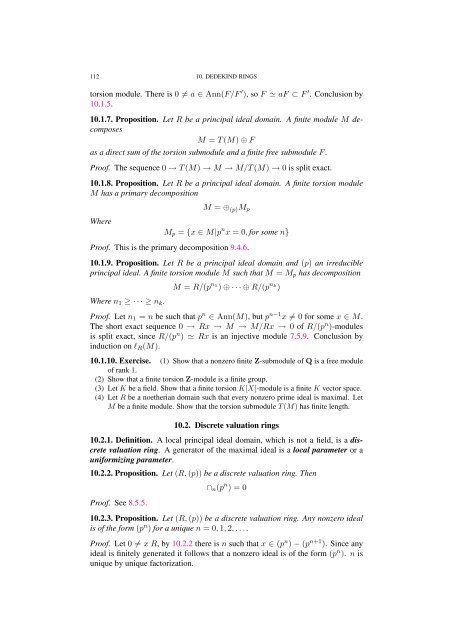Commutative algebra - Department of Mathematical Sciences - old ...
Commutative algebra - Department of Mathematical Sciences - old ...
Commutative algebra - Department of Mathematical Sciences - old ...
You also want an ePaper? Increase the reach of your titles
YUMPU automatically turns print PDFs into web optimized ePapers that Google loves.
112 10. DEDEKIND RINGS<br />
torsion module. There is 0 = a ∈ Ann(F/F ′ ), so F aF ⊂ F ′ . Conclusion by<br />
10.1.5.<br />
10.1.7. Proposition. Let R be a principal ideal domain. A finite module M decomposes<br />
M = T (M) ⊕ F<br />
as a direct sum <strong>of</strong> the torsion submodule and a finite free submodule F .<br />
Pro<strong>of</strong>. The sequence 0 → T (M) → M → M/T (M) → 0 is split exact.<br />
10.1.8. Proposition. Let R be a principal ideal domain. A finite torsion module<br />
M has a primary decomposition<br />
Where<br />
M = ⊕ (p)Mp<br />
Mp = {x ∈ M|p n x = 0, for some n}<br />
Pro<strong>of</strong>. This is the primary decomposition 9.4.6.<br />
10.1.9. Proposition. Let R be a principal ideal domain and (p) an irreducible<br />
principal ideal. A finite torsion module M such that M = Mp has decomposition<br />
Where n1 ≥ · · · ≥ nk.<br />
M = R/(p n1 ) ⊕ · · · ⊕ R/(p nk )<br />
Pro<strong>of</strong>. Let n1 = n be such that p n ∈ Ann(M), but p n−1 x = 0 for some x ∈ M.<br />
The short exact sequence 0 → Rx → M → M/Rx → 0 <strong>of</strong> R/(p n )-modules<br />
is split exact, since R/(p n ) Rx is an injective module 7.5.9. Conclusion by<br />
induction on ℓR(M).<br />
10.1.10. Exercise. (1) Show that a nonzero finite Z-submodule <strong>of</strong> Q is a free module<br />
<strong>of</strong> rank 1.<br />
(2) Show that a finite torsion Z-module is a finite group.<br />
(3) Let K be a field. Show that a finite torsion K[X]-module is a finite K vector space.<br />
(4) Let R be a noetherian domain such that every nonzero prime ideal is maximal. Let<br />
M be a finite module. Show that the torsion submodule T (M) has finite length.<br />
10.2. Discrete valuation rings<br />
10.2.1. Definition. A local principal ideal domain, which is not a field, is a discrete<br />
valuation ring. A generator <strong>of</strong> the maximal ideal is a local parameter or a<br />
uniformizing parameter.<br />
10.2.2. Proposition. Let (R, (p)) be a discrete valuation ring. Then<br />
Pro<strong>of</strong>. See 8.5.5.<br />
∩n(p n ) = 0<br />
10.2.3. Proposition. Let (R, (p)) be a discrete valuation ring. Any nonzero ideal<br />
is <strong>of</strong> the form (p n ) for a unique n = 0, 1, 2, . . . .<br />
Pro<strong>of</strong>. Let 0 = x R, by 10.2.2 there is n such that x ∈ (p n ) − (p n+1 ). Since any<br />
ideal is finitely generated it follows that a nonzero ideal is <strong>of</strong> the form (p n ). n is<br />
unique by unique factorization.
















